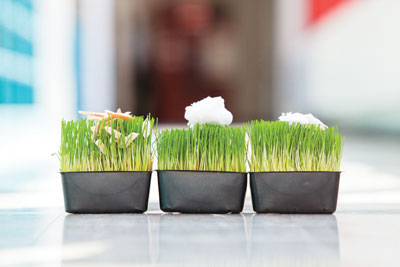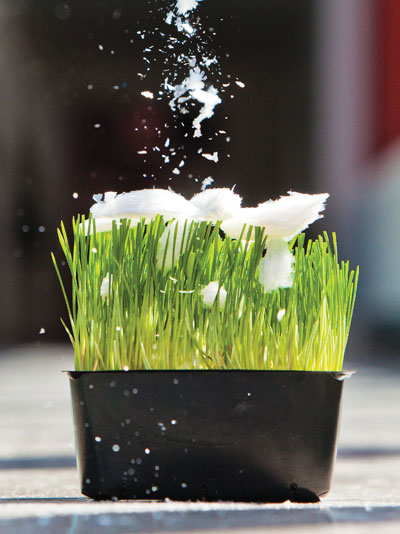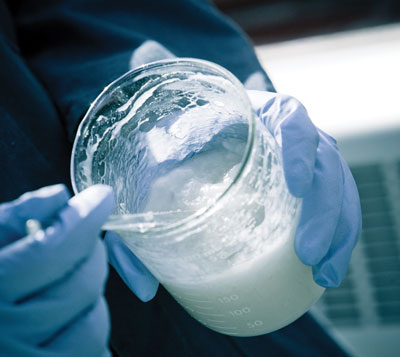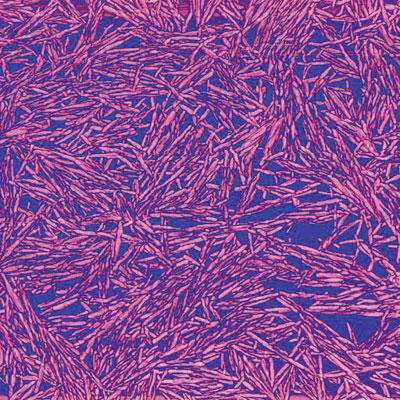
Pure Green
February 16, 2012
By
David Manly
Researchers are always looking for the next big thing: an innovation that can change the way something is done or add value to an already existing product
Researchers are always looking for the next big thing: an innovation that can change the way something is done or add value to an already existing product. One of the biggest problems, however, is that making such a leap takes a long time.
 |
|
| Three stages of processing: wood chips, tree fibre pulp and nanocrystalline cellulose.
|
One such discovery showing potential as it makes the rounds is nanocrystalline cellulose (NCC), which is obtained by milling cellulose from pulp and then using acid to dissolve the bonds that hold the chains of cellulose together. This process allows the crystallized regions within the chains to be separated out and concentrated for industrial and commercial use into slurry.
Once dried and refined, the white flakes of NCC, which range from 100 to 200 nanometres in length, resemble fallen snow and can be further processed for application in a variety of industries.
“It’s a nanofibre from wood, and has the capabilities of exploiting the strength of trees into other materials,” says Jean Moreau, president of CelluForce, a NCC development project between FPInnovations and Domtar Corporation located in Windsor, Quebec.
Of all NCC’s potential uses, one of the most attractive properties is that it can add a great deal of strength to any product. According to research done by CelluForce, NCC is purported to have greater tensile strength than stainless steel.
As well, Moreau says that there are four general product categories that NCC can improve:
- Iridescent films and barriers, such as pigments and packaging
- Coatings (such as paints and varnishes)
- Textiles
- Composites
Not only that, but since NCC is extracted from wood fibre, it is also renewable, recyclable and a source for sustainable development.
First in the world
Canada is leading the pack in NCC research and application, with two projects in various stages of development: one in Quebec and the other in Alberta.
 |
|
| Nanocrystalline cellulose dries into a small flaky powder; which looks like snow.
|
Attached to an old Domtar paper mill, CelluForce (www.celluforce.com/en/index.php ) has built a demonstration plant in Windsor, Quebec, which was scheduled to begin operation in early January 2012. The goal of the plant is to “slowly ramp up production to the target capacity of one tonne per day of nanocellulose,” says Moreau.
According to Moreau, the approximately $46-million demonstration plant is funded via $10 million from the Quebec government through Domtar, $23 million from Natural Resources Canada ($21 million from FPInnovations and $2 million from Domtar), and an additional $11 million from Domtar and $2 million from FPInnovations.
In effect, both Domtar and FPInnovations have contributed $23 million each and share 50 % of the company.
The main goal of the plant is not to become a commercial operation, which Moreau says should be able to produce 25 tonnes of NCC per day, but to run market trials and show precisely what can be done with the product through collaborations with researchers and industry partners.
Moreau, a former chartered accountant and CFO of Domtar, believes that the applications of NCC are the wave of the future, as it is practically a perfect product.
“The crystals are bio-compatible, bio-compostable, recyclable and renewable.”
In the West
Alberta Innovates – Technology Futures (albertatechfutures.ca/Home.aspx) is a research and innovation company spearheading the other Canadian NCC project.
 |
|
| Dr. Robert Jost is a researcher focusing on nanocrystalline cellulose with Alberta Innovates – Technology Futures.
|
Located in Edmonton, the $5.5-million pilot plant is funded by a $2-million grant from the Alberta government’s Ministry of Advanced Education and Technology and a $2.5-million federal grant provided by Western Economic Diversification. Alberta Innovates – Technology Futures (AITF), provides the remaining $1 million. The plant is set to be completed in summer 2012 and begin operation shortly after.
Dr. Robert Jost, the lead researcher of the NCC program at AITF, says that the most unique property of NCC is that it does not behave like wood pulp or polymers, but something completely different, which gives it potential for use in various applications.
“The point of the pilot plant is to really expand the products we are working on, increase activity and build up commercial applications and product demand,” says Jost. “Our idea is to use NCC to improve product properties or be used as a substitute for cellulose.”
Since cellulose is a ubiquitous polymer that is found in a whole host of industries and products, everything from cosmetics to aerospace engineering, it has wide applications. And NCC, which is derived from cellulose, can be used in all the same products, as well as many more.
”Because of its unique properties, cellulose polymers have found their way into everything from salad dressings to toothpaste and other products we use every day, and people probably don’t even know they are ingesting or rubbing cellulose on their hands as a cream,” says Jost.
The potential for NCC goes even beyond that, with energy being a key area of development and research, according to Jost.
“Within AITF, we have a large petroleum division, that we are actively working with developing the use of NCC for some of their applications,” says Jost.
“In the oil industry, water is used heavily for energy extraction. We are investigating using NCC as an additive to maybe give a unique property that the industry does not have, or a reduction of another additive/chemical that is currently used. That could be either an environmental benefit or a cost-savings benefit.”
Applications abound
There are two types of applications for NCC, says Yaman Boluk, nanofibre chair in forest products at the University of Alberta, high-volume and low-volume.
 |
|
| Once the NCC is extracted, it must be dried from the resultant slurry to make a usable product.
|
“High-volume applications span composites, paints and other materials where the NCC can be incorporated (such as coatings), [but] low-volume applications are the bio-medical materials that are very expensive, such as tissue engineering, bonding, drug/gene delivery.”
Boluk is collaborating with AITF on the NCC pilot plant in Edmonton, and works on observing how NCC reacts with different chemicals/materials for potential application use. Through this, he can help develop commercial products and observe how specific conditions can affect the properties of NCC.
“The next step, once the pilot plant is operational, is to improve the process development,” says Boluk. “In the meantime, once the materials are available, there will be different applications projects with other companies and researchers.”
The downside
With all the potential benefits that NCC can provide – strength, durability, security, iridescence and more – what is the downside?
According to Moreau, the biggest hurdles are getting the commercial programs up using available technology, and running and passing all the safety regulations with Health Canada, Environmental Protection Agency and Food and Drug Administration.
“And so far, all the tests reveal that it is as toxic as table salt.”
Once all that is completed, and NCC can be produced at a commercial scale, it will be on its way to developing a new fibre-based market in Canada and around the world.
Bio Vision sets its sights on NCC
There is another player in the Canadian market for NCC, a Nova Scotia company known as Bio Vision Technology Inc. Using biomass stream fractionalization and a proprietary process to release the NCC from the biomass, as opposed to acid, like AITF and CelluForce, Bio Vision has created carboxylated nanocrystalline cellulose known as “Nanocel.” The methods were developed in conjunction with the NRC Biotechnology Research Institute. “Carboxylated NCC is also easier to work with than the NCC made using sulphuric acid,” says Allen, “because it provides a chemical handle that you can use to attach other chemicals in order to produce tailor-made NCC suitable for various applications as a performance enhancer.” |
Print this page
